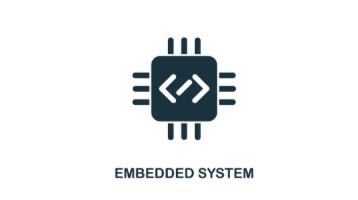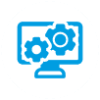Mastering Embedded Systems
From Basics to Real-World Applications
Master embedded systems programming, hardware interfacing, and design principles through hands-on projects. Develop expertise in creating efficient and reliable embedded systems with a focus on hardware interaction, troubleshooting, and real-time operating systems (RTOS). Gain practical skills in power optimization, security measures, and rapid prototyping, culminating in a diverse project portfolio showcasing your proficiency in embedded system design for applications like robotics

Course Objectives:
Fundamentals of Embedded Systems: Learn microcontroller basics and programming.
Hardware Interfacing: Connect various components to microcontrollers for input/output.
Debugging and Troubleshooting: Master debugging techniques for embedded systems.
RTOS and Wireless Communication: Explore real-time OS and wireless protocols for IoT.
Energy Efficiency: Implement low-power methods for energy optimization.
Security Measures: Develop strategies to protect systems from threats.
Prototyping with Arduino: Acquire rapid development skills.
Advanced Concepts: Explore AI and machine learning integration.
Hands-On Projects: Apply knowledge through diverse projects.
Robotics and Battery Optimization: Design and extend battery life for robotics.
Essential Information Before You Begin!
What is Embedded System?
What is Embedded System?
An embedded system is a specialized computer designed to perform specific tasks or functions within a larger system. It is typically dedicated to a single purpose and is found in devices like household appliances, cars, medical instruments, and consumer electronics. These systems operate in real-time and often have resource constraints, requiring them to be highly efficient and optimized for their intended use. They consist of specialized hardware components and rely on software to control their operations.
Benefits of the course?
Benefits of the course?
This embedded systems course offers a range of key benefits. It provides a solid understanding of microcontroller architecture and programming, essential for creating functional embedded systems. Participants also learn about real-time operating systems, enabling them to develop applications with prompt responsiveness. The course covers wireless communication protocols for IoT applications and emphasizes energy-efficient techniques. Additionally, students gain proficiency in security measures to protect embedded systems. Hands-on projects provide practical experience and a portfolio of completed work, enhancing employability.
Embedded Systems Certification Course
Excel in Embedded Systems Certification for Lucrative Opportunities by Mastering These Vital 12 Core Skills
C/C++
Programming
Microcontroller & Microprocessor
Real-Time Operating Systems (RTOS)
Hardware
Interfacing
Embedded Systems Design
Peripheral Interfaces (SPI, I2C, UART)
Analog and Digital Signal Processing
Memory
Management
Debugging and Troubleshooting
Low-Power Optimization Techniques
Wireless Communication Protocols
Security Measures for Embedded Systems
COURSE CURRICULUM
- Understanding the concept and significance of embedded systems.
- Differentiating between microcontrollers and microprocessors.
- Introduction to popular microcontroller families.
- Components and architecture of an embedded system.
- Hardware-software co-design.
- Basics of real-time operating systems.
- Scheduling algorithms in RTOS.
- Comparison of programming languages (C, C++, Python) in embedded systems.
- Configuring and controlling I/O ports.
- Interfacing with sensors and actuators.
- Writing and debugging embedded C programs.
- Understanding interrupts and their handling in embedded systems.
- Using timers and counters for timing operations.
- Applications in real-time systems.
- Serial communication (UART).
- I2C and SPI communication.
- Bluetooth and Wi-Fi communication in embedded systems.
- Building IoT applications.
- This chapter will discuss the different operations that can be performed on Azure Storage, such as creating, managing, and accessing blobs, files, and tables.
- This chapter will teach students about the different database services that are available on Azure, such as Azure SQL Database, Azure MySQL Database, and Azure PostgreSQL Database.
- This chapter will discuss how to monitor Azure resources, such as VMs, VNETs, and applications.
- This chapter will teach students about Active Directory Domain Services (AD DS) on Azure, which can be used to manage user identities and permissions in Azure.
- This chapter will discuss the different security features that are available in Azure, such as Azure Active Directory, Azure Key Vault, and Azure Firewall.
- This chapter will teach students about Infrastructure as Code (IAC) and Azure Resource Manager (ARM) templates, which can be used to automate the deployment and management of Azure resources.
- This chapter will teach students how to use Azure PowerShell, which is a command-line tool that can be used to manage Azure resources.
- This chapter will discuss the different ways to migrate workloads to Azure.
- This chapter will provide students with tips on how to prepare for an Azure administrator interview.
Capstone Projects: From Concept to Completion, Dive into Real-World Projects!

Traffic Control System
Design an intelligent traffic control system that uses real-time data from cameras and sensors to optimize traffic flow at intersections. This embedded system will manage traffic lights dynamically, reducing congestion and improving road safety.

Car Parking System:
Develop an automated car parking system with RFID technology for efficient vehicle entry and exit management. This project will include a user-friendly interface, automated payment processing, and real-time availability updates, making urban parking hassle-free.

Bluetooth-Based Home Automation:
Create a home automation system using Bluetooth connectivity to control lights, appliances, and security systems from a smartphone app. This project offers convenience and security by enabling users to remotely manage their home environment.

IoT-Based Temperature Monitoring:
Build an IoT-based temperature monitoring system using sensors and a cloud platform. This system will provide real-time temperature data for various applications such as cold storage, weather stations, and home climate control.

IoT-Based Home Automation (ESP8266):
Implement a home automation system using the ESP8266 microcontroller, allowing users to control lights, fans, and smart devices through a mobile app. This cost-effective and customizable solution offers energy savings and enhanced living comfort.

Bluetooth-Based Temperature Monitoring System:
Design an ESP8266-based temperature monitoring system that uploads data to ThingSpeak for remote tracking and analysis, enabling users to monitor temperature conditions in real-time across diverse applications.
Attend our Live Webinar for an interactive session with our Experts
Join online sessions and interact with the trainer to ask questions and gain a better understanding.
Get Instant Access to the Embedded Systems Course
If you are ready to learn and upgrade your skills in the Azure Administrator Certification Course, simply choose your payment option below & click the Enroll Now button to get access
Enroll Now




Frequently asked questions
This embedded systems course is designed for a wide audience, including students in electrical and computer engineering, professionals seeking to enhance their skills, software developers looking to enter the embedded systems field, tech enthusiasts and hobbyists, entrepreneurs interested in IoT and robotics, and anyone curious about technology and embedded systems.
In this course, you will learn the fundamentals of embedded systems, including hardware interfacing, debugging, and real-time systems. You'll also delve into wireless communication, energy efficiency, and security measures. Practical skills in prototyping, advanced concepts like AI integration, and hands-on projects will be part of your learning journey. By the course's end, you'll be well-prepared to design, develop, and optimize embedded systems for various applications, from IoT to robotics.
Typical prerequisites for an embedded systems course include basic programming skills (C/C++), a grasp of electronics fundamentals, and a foundational understanding of mathematics and computer science concepts. Prior familiarity with microcontrollers is advantageous, but a strong motivation to learn and an interest in embedded systems are essential. Specific requirements may vary by course.
Yes, after completing the course at LevelUp, you will receive a certificate of completion.
Beginners will do 20 Projects while the Experienced students will be Asked to do 5 Advanced Projects
